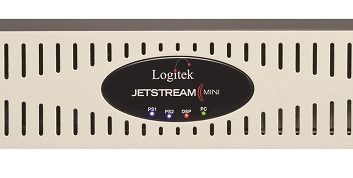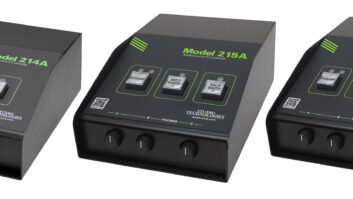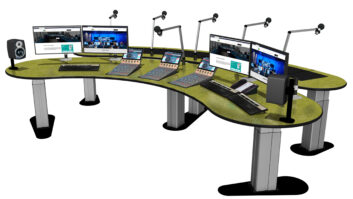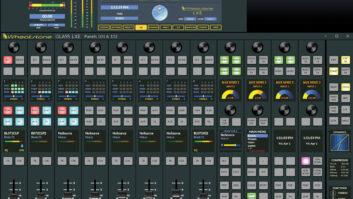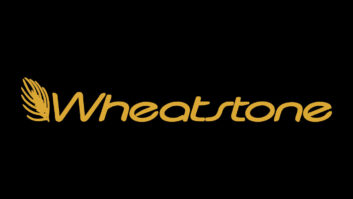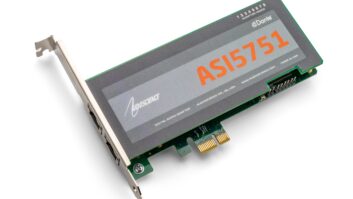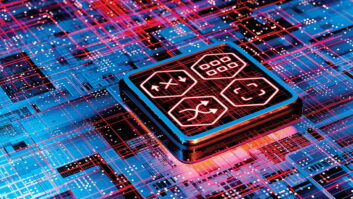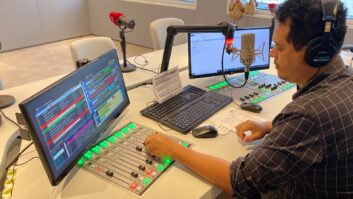This is the unabridged version of the question and answer piece that appeared in Radio World’s latest eBook, “Trends in Consoles.” As part of that eBook, Radio World surveyed representatives of numerous console manufacturers for their thoughts concerning where consoles are going. Participants who replied to the invitation include Ben Palmer, sales manager, Arrakis Systems; Kirk Harnack and Marty Sacks, Axia Systems; Pascal Malgouyard, head of marketing, Digigram; Clark Novak, radio marketing specialist, Lawo; Tag Borland, president, Logitek Electronic Systems; Dan Braverman, president, Radio Systems; Jay Tyler, director of sales, Wheatstone; and Hanno Mahr, CEO, Yellowtec. All replied individually to the questions shown.
Radio World: Does your company make analog consoles? Does it plan to continue research into and development of analog consoles?
Ben Palmer: Yes we do. Yes, so long as there is analog source equipment to take, there will always be a market for analog consoles.
Dan Braverman: Radio Systems remains just one of a few broadcast console manufactures that “still” manufactures analog consoles. We do so simply because demand remains strong, not only from users that want to match a board they bought from us years ago but also those that will always prefer the simplicity and dependability of analog.
In fact or new line of consoles due later this year will be fully featured, yet still analog boards to continue to fill and expand on this need.
Jay Tyler: Wheatstone still makes analog consoles and actually, consoles like the Audioarts Air-1 and Air-5 are still very popular among one-studio operators. But I think we all agree that IP consoles are where it’s at in terms of usability and cost.

Ben Palmer, Arrakis Systems
Radio World: Is the analog console dead?
Kirk Harnack: Not at all. Analog consoles are still useful, especially for quick remote broadcast and sports mixing applications. Most are not networked so they cannot share audio, which makes them disadvantaged in a normal studio environment.
Ben Palmer: Most definitely not. There are many applications where analog consoles are more appropriate and a better fit for studios, or remotes. So long as there are analog source equipment to take, there will always be a market for analog consoles.
Jay Tyler: I wouldn’t say it’s dead. Wheatstone still makes analog consoles and actually, consoles like the Audioarts Air-1 and Air-5, are still very popular among one-studio operators. But I think we all agree that IP consoles are where it’s at in terms of usability and cost. There are still many who want an analog console, but it’s certainly not in its glory days.
Hanno Mahr:For radio, yes!
Tag Borland: Pretty much. We made our last analog console in the 1990s. While there are some low-end analog consoles still out there, the cost of an entry level digital/networked console is dropping to the point where even the smallest station can afford to leave the old way of doing things behind.
Harnack: Not at all. Analog consoles are still useful, especially for quick remote broadcast and sports mixing applications. Most are not networked so they cannot share audio, which makes them disadvantaged in a normal studio environment.
Braverman: It is tempting (but I think self-serving of analog manufacturers) to compare the benefits and continued use of analog consoles to the resurgence of vinyl records or tube amplifiers. This is because, while it has always been true that a well-designed analog board sounds better than digital, these subtle audio quality enhancements are lost in the transmission process.
The benefit of analog is dependability and value. Where the routing capabilities of an IP or router-based platform are not needed analog boards offer a tremendous and ongoing value to thousands of stations and studios.
Radio World: IP technology has taken the console industry by storm, are there any downsides to it?
Borland: Latency is a permanent downside to IP. The store and forward nature of the technology increases the time between someone speaking and hearing their voice in headphones. While most talent can adjust to the new sound of their voice in a few days, some never do. The complexity that virtualization and IP transport allows is a problem if something goes wrong. It can even be difficult to know in what room or city the failure is occurring. A lack of interfacing standards creates a silo effect between products from different manufacturers. There remain many places where IP audio must be converted to analog or AES3 to bridge between IP enabled equipment.
Pascal Malgouyard: The broadcasters have now realized that interoperability at system level between manufacturers is important to keep control of their own workflow. Currently this is only partially addressed by AES67, which has been intentionally limited to audio streaming and clock synchronization. To date, equipment control is widely proprietary, hence limited to equipment belonging to the same ecosystem as the console manufacturer.
Mahr: The administration is not yet intuitive, data are easily tapped and sometimes it is hard to do error analysis.
Palmer: With AES67 and soon to be AES70, there’s not a lot of downsides to AoIP anymore. The reliability and ease of use is all there now as well. That said, the cost has been the biggest downside to AoIP. But over the next couple years, with newer, and more affordable solutions, it is going to be in the reach for any station.
Tyler: There’s been this perception that IP is not reliable. In the early years, that may have been the case. But I think it’s proven itself to be quite reliable, especially since there are redundancies built into systems like WheatNet-IP. One Blade in particular that’s been operating at a station for years now showed that it has 1,053 days (as of May 23) continuous uptime, which is remarkably reliable. Before a disruption for a station UPS replacement it had logged 1,400 days straight.
Marty Sacks: Using AoIP technology solves nearly every audio problem that has plagued analog audio for decades. Hum, buzz, ground loops, and RF interference are all but completely gone with AoIP implementations. The “downside” to IP technology is there are new techniques to learn. As with any tech, there are “gotchas” for those who haven’t yet learned the fundamentals of IP networking. The good news is, these problems tend to occur once — at installation time. Once any networking foibles are corrected, they don’t return unless someone haphazardly reconfigures something.

Kirk Harnack, Axia Audio
Radio World: Has the IP console/IP network changed the role of the console and the workflow of the radio facility?
Tyler: Definitely. Broadcasters used to have one studio for one show, or a studio that was used strictly for production. The flexibility of the IP-networked console changed that radically. They’re able to repurpose studios, change broadcast locations, and more recently, extend that studio beyond the station walls. I’ve seen studios that are half the size of what they might have been if not for IP audio networking, and of course all the wiring that goes with those larger studios goes by the wayside as well so you’re seeing considerable cost savings and operation efficiencies as a result.
Malgouyard: Yes, particularly in the functional relationship between automation and the console, where IP technology gives the option to automation for driving the workflow at the system level.
Palmer: It has changed the way the user is able to access their content. The roles are still similar in nature, but more flexibility gives the user the ability to do more with less hardware and wiring.
Sacks: Workflow for talent is largely the same as with analog- or AES3-connected consoles. What is notable is the absolute clarity of audio from beginning to end. With AoIP infrastructure and consoles, the same bits (ones and zeros) that were in the original audio are pretty much exactly the same in the finished product. There is no noise buildup and no added distortion through multiple passes through console I/Os, faders, and PC-based recorders. Digital audio math is — math; it’s repeatable, predictable, and basically perfect. And, if desired, workflows can be much more flexible with AoIP. Because of the great cost advantage over 60s-era TDM technology, smaller facilities can utilize AoIP and enjoy the more flexible workflows that they could only dream about in the past.
Borland: It’s not that the console has changed the station workflow, but the advent of computers has expanded what can be created economically. Console functionality has adjusted to accommodate this.
It’s trivial to do multitrack editing on a computer today and you don’t need a console with a special mixing architecture to produce multitrack audio. Back in the day, you needed a very large and expensive board and an 8-track tape deck was a luxury that only the major markets could afford. Today you can do it on any computer or most tablets with software ranging from free to a few hundred dollars. This means that a production studio can today get the job done with just a handful of faders — or it can produce award winning spots with no console and just a router control head.
In the control room, any station can do more with fewer faders since you’re no longer limited to an A/B switch for inputs. With a router based board the only question is: how many sources do you need to use simultaneously?
Radio World: What are your thoughts on Dante, Ravenna, AES67, Livewire, WheatNet, et al? Are they sufficient for your needs or does there need to be one, all-encompassing standard?
Tyler: Interoperability is something that we as a manufacturer support because it makes our systems more portable. We think it’s important to be able to at least exchange audio between systems, and to a large extent AES67 does that. More needs to be done to bring along other aspects of interoperability like control, although we’ve had success with standards like AES70, for example.
Palmer: Dante is by far the most popular, with over 250 manufacturers using the protocol. But with AES67, it allows other proprietary protocols to mingle in the same network. This is excellent for converging newer systems, such as Dante, to work with older existing systems and protocols. Certainly with AES70, you will see an even greater and more powerful ecosystem for AoIP.
Borland: IP audio is facing growing user annoyance because the noncompatibility between vendors limits what equipment a facility can choose. The thing that makes digital audio universal is that everyone follows the same AES3 standard. We think that AES67 is a good start for IP audio, and the AES70 standard and a robust discovery protocol will fill in a lot of details that will make networked audio just as universal as digital is today. As a manufacturer we believe that compliance with international standards will speed the adoption of the technology.
Mahr: In terms of new products a universal, all-encompassing standard is desirable to facilitate product development. AES67 is a small step towards it but there is still the need of a centralized control made available. In the end, not one, all-encompassing standard is the key, but the fact that various networks are able to communicate in the best possible way with as little restrictions as possible.
Malgouyard: AES67 is quickly becoming the interoperability trunk for clock distribution and audio streaming. Of course, a common discovery and, above all, a common multivendor control standard are still missing to complete these items intentionally left aside of AES67.
Harnack: As with any competitive endeavor, the AoIP ecosystem for broadcast has developed in a fragmented way. This is actually quite natural, and even proper. Of course, we’d like to see Livewire be the worldwide standard. Actually, among radio broadcasters, Livewire is the de facto standard with the majority of installations and technology partners. However, the pro sound market is probably better served by Dante, as many of these installations are temporary. Plug-and-play convenience is more important than the attributes of Livewire that make it perfect for broadcast workflows. Livewire offers excellent and easy discovery, routing and reliable GPIO signaling. It’s truly point-and-click. Other AoIP systems for broadcast are very good, too. Each offers some benefit for broadcasters.
Which brings us to AES67. Over a decade back, Telos founder Steve Church proclaimed that a “common tongue” was needed so that any AoIP device could connect with any other. Telos helped start the AES-X192 working group, the group that hammered out what became AES67. The purpose of a common AoIP standard — AES67 — is not to replace the other AoIP protocols. Indeed, the competing — and slightly incompatible — protocols from various manufacturers are highly developed to best serve their users’ needs. AES67 is simply a common audio connection protocol that manufacturers may include along with their existing, refined, protocols.
Indeed, if we tried to have “one, all-encompassing standard” we would lose a lot of convenience and flexibility that we get now.
Our advice is to choose the broadcast equipment you really like and has enough existing partners and a large enough ecosystem to make sense for your facility. Use that equipment and protocol (Ravenna, Livewire+ AES67, etc.) to its fullest extent and convenience. Then, use AES67 where you need to connect devices that do not natively offer your chosen standard.

Marty Sacks, Axia Audio
Radio World: What’s the next step for IP technology (vis a vis radio broadcasting)?
Mahr: Standardization, standardization, standardization.
Borland: We see more remote mixing and monitoring in the future. It’s one of the reasons we have added motorized faders to our products and have spent a lot of time working with multi-platform touchscreen technology.
Palmer: I believe you will see more software/touchscreen-based mixers that can access any source on the network. Utilizing standard Windows systems, it will be extremely powerful to have the ability to control your systems from anywhere in the world.
Malgouyard: One of the next steps consists in controlling AoIP at the system level (compared to equipment level) with multivendor tools in an audio orientated way, and not as IT, including end-to-end redundant audio routing, clock distribution and generic controls. Another step, already underway, consists in using IP to progressively move most, if not all, the audio processing and content management into the cloud so that the different actors may benefit from its flexibility, scalability and distributed workflow access.
Sacks: We’ll see AolP tech on practically every piece of equipment — even microphones, speakers, headphone amps, etc. We’ll see entire facilities built with AC power cords and Cat-6 cable dominating the cable plant. Moreover, some of those AC power cords will give way to Power over Ethernet (PoE) technology, making wiring even simpler.
We’ll witness more ease of managing our separate yet connected LANs (AoIP and business LANs). We’ll watch the virtual disappearance of RCA plugs, nine-pin D-sub connectors, and even XLRs. We’ll observe as audio never leaves the IP or DSP realm until it comes out the control room speakers and headphones, plus the listeners’ speakers or headphones.
A key part of the next steps in IP technology is the continuing education of broadcast engineers, and the rise of a new generation of IT-centric engineers. We have to hope the new generation is as passionate about pristine audio as most of us have been. AoIP gives them the perfect platform to keep audio just perfect.
Tyler: If we want to know what the future holds, all we have to do is look out at what’s happening in telecommunications and in enterprise systems. We are all influenced by smartphones and tablets and just the ubiquitous nature of data today. That’s the future of IP, where we are able to interact more easily with the console, whether it’s a physical console or a virtual one like the one we had on a tablet at the NAB. Like mobile phones, I think the console will be whatever it is that broadcasters want it to be. There are so few limitations anymore, and that’s the point of consoles like our LXE. You build your own.
Radio World: Is it the console that matters or the network that is the key piece?
Clark Novak: They’re both key pieces. The console is the key human interface, the terminal point of control. The network is just as essential; with facilities and distribution systems increasingly linked via IP, a robust network is a must-have.
Borland: While the network is important because you need the audio available to work with, we believe that the user experience is everything. We’ve spent a lot of time looking at how people use consoles and have tasked a new design team at our Australian office with creating a better user interface while our Houston team focuses on the infrastructure.
Palmer: We utilize Dante, which works with any standard network router or switch. So the network isn’t as important to the user, as it simply runs in the background, undisturbed. The user will care more about the hardware and software that they interface with on a daily basis.
Harnack: The network is now really the key — with one incontrovertible exception: When a board operator, key talent, or anyone who needs to create great radio is using the console, then it is what matters. Even if our consoles morph into fabulous touchscreens, they’ve got to feel great and work exactly as expected. Console need to work effortlessly so the talent can focus on content.
Mahr: Nowadays, consoles and networks are deeply integrated. One cannot work without the other. Depending on a console’s features, the importance of the network can rise or fall.
Malgouyard: With IP, a continuity exists between the network — which intelligently routes audio streams, clock synchronization and metadata — and the console which can be seen as a collection of smart processing and I/O nodes of any size, devoted to each part of the workflow. The key piece is probably the overall system architecture and control of this unified system.
Tyler: That’s an interesting question that we ask ourselves a lot at Wheatstone. We probably need a new way of looking at this. Instead of seeing these as separate elements, we should probably be looking at this as one large system. IP consoles are merely the front end to the network — it’s an interface to it. Once we understand that concept, it frees us up to really take advantage of what networking can do and how to best interface to that. In many ways we’ve already started down that path a long time ago by including virtual mixers inside our Blades. Mixing used to exist in the hardware realm only, but by virtualizing them as a service or resource on the network, we can do so much more than we thought possible before.

Pascal Malgouyard, Digigram
Radio World: Is there any technology on the horizon to supplant IP technology?
Harnack: “Supplant”? No, not yet. Augment and expand? Absolutely.
As broadcasters take uptime seriously, we’ll continue to use wired IP technology for the foreseeable future. CAT6 cable manufacturers will be in good stead for a while. We will continue to see leaps in wireless tech. Ample bandwidth will allow even more flexibility and assured mobility both inside the broadcast facility and when going out on remote broadcasts.
Malgouyard: Though IP technology was not invented with real-time media streaming in mind, the broadcast industry has successfully adopted and adapted to it. We should keep an eye on the evolution (or mutation) of IP technology in other industries that could be used in the broadcast industry.
Mahr: IP technology is still at its beginning for radio. Rather than another technology taking over, we expect an evolution of IP technology.
Borland: The beauty of IP is that it can reduce hundreds of wires between equipment to just one. Until the number of wires can be reduced below one IP will dominate.
Tyler: I’ve been reading about quantum computers and quark-scale computing. I think we can do some really interesting things with that! But seriously, moving data around — that is, moving audio around — is what we’re really talking about here, and I’m sure technology by whatever name will expand and grow to make that easier, faster, better.
Radio World: As we live in a technologically bountiful time, the cost of electronic components has dropped while the capability of said components has increased. Are we living in a golden age? Does the inexpensive availability affect design choices, especially considering possible rapid improvement in components while still in the design phase (or initial production)?
Mahr: We are definitely in the middle of a golden age speaking of the availability of electronic components. Nevertheless, all the options available cause problems in anticipating the future development of electronics. Rapid improvements in components make it difficult to define the product you’re developing in the design phase. Thus, there is a need for periodic adjustments that may change the product you are working on leading to a different feature set.
Sacks: We do live in a bountiful time. We can see dramatic and positive changes in tech every decade, every year, every month, and almost every day. In mass quantity we see component costs becoming quite cheap; and, as consumers, we may have similar expectations for broadcast equipment.
The truth, though, is that equipment built solely for the broadcast industry is made in small batches — very small batches when compared with consumer or even prosumer manufacturing scales. And while components may be cheaper, even in small quantities, their long-term availability is constantly threatened.
Broadcast manufacturers must choose components wisely, especially in displays and even microprocessors. Parts makers are always building the next big thing for the big guys, leaving tricky choices for broadcast equipment manufacturers.
Tyler: As a manufacturer, there’s always a balance you have to strike between what’s new and what’s proven. On the one hand you want to be able to take advantage of all the new technology coming out, but not if it’s unproven or doesn’t do as advertised. That’s why companies like Wheatstone invest so much in R&D. There are many good examples of technology that has reached a sort of reliability and price mark that make it appealing to broadcasters. OLED and touchscreen technologies are good examples. These were once new and unproven, but we use them throughout our system and can do things we couldn’t have done otherwise as a result. Linux is another example. We can do things with Linux that we couldn’t dream of doing before.
Borland: I’m sure that if you asked this question 40 years ago, they’d tell you we were living in a golden age, too. New technology is always cool. What is changing is that the life cycle of components — the time between when a component is introduced to when it is obsoleted — is becoming much shorter. Since stations want to hang on to their audio consoles a lot longer than the average consumer hangs onto their mobile phone, we have to make design choices that give us the capability to support an audio console over about a 10-year period even if some of the major components change during that time.
That being said, new technologies make it easier to bring things to market faster. By moving a lot of functions from buttons to touchscreens and taking advantage of a 24-hour development cycle by using global design teams, Logitek was able to develop the prototypes of the Helix console in about three months. We think that qualifies as “golden age.”
Palmer: Most definitely. The costs are dropping significantly, and chips and components are more powerful. With more open source hardware and software, we are able to develop faster, more effective, and bring greater advancements to the consumer.
Malgouyard: The low cost of electronic components is largely due scales of mass production. This directs the architectural choice of industry professionals — both designers/manufacturers and consumers — who may now leverage the huge resources of the IT technology world rather than relying on custom-designed equipment, components or even software.

Clark Novak, Lawo
Radio World: Will large touchscreen-based consoles, looking like Star Trek equipment, be common/affordable for the mid- and small-size station or are such things more like supercool concept cars at auto shows?
Novak: Moore’s Law has not been repealed. Science-fiction keeps turning into science-fact, and technology keeps getting more affordable; the average cellphone has more power than an IBM supercomputer of the ’60s. This trend will continue, with touchscreen interfaces affordable and desirable for stations of all sizes. In fact, consoles based on PC platforms, using touchscreen GUIs and running studio tools as apps, could save stations quite a bit of money compared to traditional hardware.
Palmer: It will definitely become more affordable over the next couple years. Touchscreen monitors are very affordable already, along with powerful PCs. Over the coming years, it will only become more affordable and accessible to everyone.
Mahr: In our opinion, large touchscreen-based consoles are anything but user-friendly. They lack usability, responsiveness and haptic control elements. Rather than producing purely touchscreen-based consoles it is key to use the achievements of the touchscreen technology to combine them with the benefits of other conventional or new control elements. The future challenge is to develop more elements that mix benefits of different technologies resulting in high usability for the operator. One step in this direction is our Intellimix’s G-Touch fader which combines characteristics of different fader technologies.
Harnack: There’s certainly progress on this front. One company has even sped up their touchscreen response time to better suit the recording industry.
Telos actually has partnered with two companies making touch screen mixing control software — BSI and IP-Studio. We also have a SoftSurface app that runs on Windows PCs or tablets, and some stations are using it to mix sports broadcasts from hundreds of miles away from the actual control room. Axia’s SoftSurface app may be used to either augment or completely replace the hardware console; so, really, we’re already at the point where touchscreen consoles are a reality.
Borland: If you can afford to buy a physical console, you can afford to buy a touchscreen-based console. The horsepower required to drive either type of console is in the audio engine. Either type of console is just the user interface.
Radio World: Touchscreen technology has crept into console hardware design, creating hybrid consoles with things like touchscreen dynamics and routing sections but physical faders remain. Is this the camel’s nose under the tent?
Borland: We spent a lot of time watching users interact with technology before we set out to build the Helix, which is Logitek’s touchscreen-based console. There are certain functions that people use while looking at the board and certain ones they use while looking somewhere else. As a result we retained physical faders and on/off buttons. When you’re on the air, it’s like you’re playing piano. Your fingers know where to go from what they feel. It’s far more difficult to play piano on a sheet of glass.
We see the potential for full touchscreen consoles in places like production studios or remote broadcasts where you’re interacting with the console less. It could also work in a talk studio where you’re also shooting video, again, when you’re not as actively operating the board.
Novak: Touchscreens give us an excellent way to streamline consoles. Typical consoles are pretty cluttered — full of knobs, displays and switches, most of which don’t get used very often. Other functions are buried deep inside menus. Using touchscreens, console designers can move functions from the surface to a context-sensitive GUI. This allows us to declutter the console by removing controls that aren’t commonly used, and give faster access to deeply-embedded features. This makes for a better user experience for jocks, because the controls they need most often are prominent on the mixing surface, while deeper functions move to the GUI.
Mahr: The benefit of touchscreen technology is the ease of making modifications by only changing software settings without any necessary adjustments in hardware. Therefore, hybrid consoles can be a fundamental, future-proof solution to optimize consoles and thereby user workflows. At the same time, this fact should be seen as a motivation to develop new control elements rather than trying to take advantage of touchscreen technology in combination with conventional physical faders.
When you need to do a smooth fade you wouldn’t dream of using a touchscreen fader, at the same time mechanical faders have their downsides. Thus, it is a mistake to stick to conventional mechanical faders. Not only the console itself but also its control elements need to be rethought. A hybrid control design can be a step in the right direction. But what is of the essence is not only to combine touch screens with physical faders but to optimize them in terms of their respective functions and their interaction. This is exactly what Yellowtec had in mind developing the Intellimix Desktop Mixer which is characterized by its multi-touchscreen combined with the all new transformation of a mechanical fader called G-Touch.
Malgouyard: In blu by digigram, both the audio engine and the mixing workspace GUI are genuinely located in the cloud, hence they are 100% virtual for the conferencing application.
Tyler: I think all of the above. We’ve been able to do incredible things with touchscreen control — pinching EQ, swiping, all that. There is a definite movement toward that kind of intuitive operation. But at the end of the day, we have to get back to the purpose of the console. It’s an interface, a user interface. And whether that comes in a package with a physical fader or a virtual fader, that will be decided by the user and he might even have different preferences for different applications. A good example of this is we all have smartphones but we all have laptops too, and tablets and some of us have desktop computers too. We use all those appliances every day, and one doesn’t necessarily take the place of the other.
Palmer: Users, including myself, seem to find comfort in having a physical interface, such as the fader. It is something that is tangible and easy to control. Certainly as we become more and more comfortable with touch screens, we may see less of a need. My children are more comfortable with a touchscreen than a mouse for example.
Sacks: Certainly, but there’s a comfort level that must be reached first. For example, new cars still have steering wheels, accelerator and brake pedals, and turn signals on a stick. On the other hand, this is how progress usually occurs; we implement new ideas in ways that feel comfortable, yet add something to the final experience. Though Axia has offered full mixing control for several years now in our SoftSurface app, uptake has been primarily in low-use or remote-control applications. Axia new IP-Tablet gives power users more shortcuts, monitoring, and insights into console status and operation, as well as allowing customization of workflows and remote control of peripheral gear.

Tag Borland, Logitek Electronic Systems
Radio World: Is the future of the console app-based — existing on smartphones or tablets?
Palmer: There can definitely be a lot of plusses for utilizing tablets and smartphones for ancillary control. But you will still have to have a physical interface for bringing in your sources. Also, depending on station needs, they may need something more than a simple tablet.
Malgouyard: App adoption will probably grow for particular uses. It will migrate usage by usage since one of the key conditions is that the coupling between smartphone or tablet control surface and audio processing must fit the workflow in terms of usage and key performances such as speed, audio latency, security and robustness.
Tyler: That exists now. There’s no question that we can, and should, mobilize access whenever and however it makes sense. We showed a LXE Windows tablet as a console at the NAB Show complete with faders and knobs, the works. Not only could you effectively change controls on the LXE and adjust dynamic off of that small tablet, as a producer might during a busy show, but you could run the entire board operation if you wanted to. All of that capability exists — and so much more because we have been able to mobilize station operation using apps.
Sacks: We’re already there now — at least at The Telos Alliance. These are options, some of which have been available since 2012. For fast-paced, full-time operation, hardware consoles are far-and-away the norm. However, we’re enthused that more broadcasters are using SoftSurface and our other apps to control audio consoles, audio processors, talk show systems and mic processors. They’re using these apps primarily for convenience, and for excellent graphical displays detailing equipment operation.
Borland: Yes. It’s not something you might do a show with every day, but if you’re going out on remote and you don’t want to use a board op back at the studio, we can’t think of an easier way to do it.
Mahr: As apps become increasingly important, they begin to enter more and more fields of operation. App-based consoles are already important for band recordings or other audio recordings while they are rather insignificant for the broadcast business so far. This might also change soon. Still the future of app-based consoles will be highly depending on their areas of use.

Dan Braverman, Radio Systems
Radio World: Is there something missing from the basic console that you’d like to see added — perhaps access to remote monitoring systems or the final processor section or transmitter control, access to a DAW or anything that’s been left out simply because it wasn’t practice or technologically feasible to include it before?
Harnack: Within The Telos Alliance, most of the applications mentioned in the question are already implemented, or can be added by the user. Adding the new IP-Tablet to the Axia product line exemplifies this kind of integration.
Worth noting is that the reverse is possible — and useful. Livewire partner Broadcast Bionics offers products that read Axia consoles’ channel status and fader position, recording those along with individual audio sources to record original source audio along with console metadata. This allows their apps to re-create a mix, but with tweaks to make the end product perfect for social media clips. Using this console metadata opens striking possibilities in content remixing and reuse. This tech is already on-air — and on social media — in London with more installations going on now.
Novak: Better-integrated control of source devices. Of course, this is hard to do with hardware alone. But using a GUI, we can place controls for processing, transmission, and studio tools onscreen, where they complement console controls. Context-sensitive GUIs are great – we can design them in a purposeful way, to enhance and amplify the actions of the operator, something we have a much harder time doing with hardware alone.
Mahr: In general, it is not desirable to shift more and more administrative functions to the console itself. However, another nice feature would be the possibility of radio hosts doing their live recordings in Asia or Africa while the studio in Europe does the fading or vice versa. Unfortunately, there are physical limits.
Borland: As more functions in a radio facility are virtualized, they’re going to need a place to live. A central place in the studio like an audio console would be a convenient place to access these controls.
Radio World: Virtualization is a buzzword these days — how realistic is it to put the console into the cloud – that is, to not have a physical facility where a DJ and an engineer might interact (with a program director peering in occasionally)?
Malgouyard: This should probably be considered case-by-case because virtualization allows different contents otherwise distributed in different silos to gather in the same processing space. For instance, blu by digigram simply solves a particular challenge by mixing in the cloud heterogeneous content sources. The talk show application is completely managed from a virtual workspace. The result of this live feed is fed to the studio on-air console by a professional interface providing the physical gateway to the cloud.
Harnack: Great question! We’re delighted to report that this is already done and on-air. One British broadcasting company’s project keeps mics, headphones and console surfaces at the local stations, while everything else is done in their own cloud network centers. All stored audio exists at the network center, and console surface manipulations in local station control rooms actually control DSP mix engines in the cloud.
This project massively reduced the amount of tech on-site in the local stations, yet keeps all the on-air talent there, in their home towns. With a lot less equipment spread around cities, towns, and hamlets, there’s far less need for engineers to maintain the gear in these local facilities.
Novak: Running apps from the cloud is very common in the IT world, so why not broadcast? IT took hardware-based technology and migrated it to virtual machines, which has some very interesting advantages. First, the tools are available anywhere you have an Internet connection. Second, apps are usually less expensive than hardware. Third, it’s scalable on-demand — need another suite of audio production tools? Just fire up a new virtual machine.
This approach may not be suitable for every radio studio, but it could be very attractive for some. And the software tools are already available — codecs, phone systems, editors, playout systems, and even mixing consoles.
Mahr: With the rise of the importance of AoIP, consoles put into the cloud seem to be a possible future scenario. The question is how to overcome the current limits in terms of speed and security.
Tyler: Well, first, you don’t need a console in the cloud to eliminate the physical facility. Broadcasters can do that already using a virtual console anywhere. But I get your point. Virtualization is the latest buzzword, but in truth, we’ve been using virtualization in broadcasting in very meaningful ways for the past decade or so. We have taken so much that was once physical boxes in the air chain and made them virtual. We’ve essentially eliminated DAs with virtual mixers and soundcards with audio drivers, for example.
Palmer: There is definitely a hybrid of the two that can work for the user. This is realistic, especially as more and more users demand more connectivity.
Borland: We’re probably not too far away from this now. If you look at how some of the online broadcasters are sourcing their talent across the globe you can see the beginnings of the trend. As the technology gets more user-friendly, we will see more of this in the future.

Jay Tyler, Wheatstone
Radio World: Could there be a “Minority Report”-style gesture-based virtual console in our future?
Borland: Alexa, turn on my microphone.
Palmer: This is already being done, and will be common place in coming years. Microsoft has their Hololens, and Myo has an armband. With these control interfaces working with a standard Windows platform, it is logical that we will be able to control a software-based console in the future. I personally love the mouse over these devices, but it should just be a matter of time before it is a standard.
Mahr: When you go back in time, you would have never imagined the technologies of today being ready for use. As the evolution of consoles will be an ongoing matter, there will also be consoles in the future that completely differ from the ones used nowadays. For certain gesture-based virtual consoles might be one kind of them although we have a little doubt about that.
Tyler: That would be one cool console! My answer is, why not? There was an entire section dedicated to virtual reality at the NAB Show, and although a lot of that is still in its infancy, I suspect that technology will make its way into our studios when the time is right. I wouldn’t be surprised if our R&D guys are experimenting with some of that now.
Sacks: Would you believe we’ve already been looking at this tech? It’s certainly in its infancy, and exists on two levels now — small, finger and hand-level gestures and larger movements appropriate for camera sensing. It’ll be quite a while before this is a reality, and we’ll certainly see it in industrial and consumer use first.
Radio World: What is the making of a perfect console?
Borland: It needs to sound clean, look clean and modern, be intuitive enough to operate that you don’t need to train an operator, and it has to suit the needs of the station.
Mahr: The key to the perfect console is usability which equals safety in broadcast environments. In the end it is not the feature set or connectivity itself that adds value to a console but the way the user is ready to unleash its potential. It is all about ease-of-use.
Harnack:
1. Reliability
2. Durability
3. Simple to use
4. Error-free operation
5. Automatic behaviors that just work

Hanno Mahr, Yellowtec
Radio World: In many cases the modern broadcast console no longer has audio running through it, it’s merely a control surface. Is it time to rethink the standard concept of the console?
Palmer: Certainly! For many scenarios, such as smaller studios or groups, it would make sense to stick with standard console interfaces. But there are plenty of scenarios where you’ll have all your audio sources running through a rack room, and the studios are filled with nothing but hardware or software control interfaces.
Tyler: The console is the front end to the network, the studio itself. That’s how we should be thinking of consoles because just about any other definition limits their usefulness.
Mahr: It is more than about time to rethink the standard concept of a console. We already did so years ago. With Intellimix we equip you with a mixer that fits any desk. Simply place its Base Unit to your rack. All you need to operate is the Control Unit. Get yourself whole new types of control elements, a wide touchscreen to control even the most complex settings with spectacular ease and an awarded product design.
Borland: That’s part of what we did when we came up with the Helix. We looked at all of the things we’ve been doing because we’ve always done it that way and then set out to do things because they needed doing. We came up with a modern interface that doesn’t get in the way of all of the other screens in the studio.
Harnack: Radio studios began by having all the audio sources in the control room, so it was natural to make the audio console the center of everything. Nowadays, it’s often the only truly local sources are mics, headphones, and speakers. If we put some I/O device in the control room we can easily connect those few local sources and destinations to the rest of the networked audio infrastructure.
Several console makers already have rethought this. It turns out that Axia consoles have never had any audio present in the control surface, as this would actually complicate the studio rather than simplify it.
Radio World: What was your favorite console or the best console ever made?
Harnack: I grew up in Central Kentucky, where many radio stations used consoles from a regional manufacturer, Shane & Young. These looked suspiciously like LPB Signature consoles, but sported model names borrowed from American Indian tribes. My first favorite was the monaural “Cherokee,” then later the stereo “Sioux.” Simple, quick and easy to operate without workflow errors.
Borland: A PR&E BMX made in Carlsbad. You knew you had made it as a talent when you ran your show on a BMX. However, that is rose-colored memory. The limited functionality, noise, cross-talk, high maintenance and general crankiness of big analog consoles makes them unusable with today’s workflows.
Tyler: Besides the Audioarts — everyone knows I’m a die-hard Audioarts fan — I’d have to say the PR&E BMX III console. They were built tough and they’ve lasted all these years later. They just keep going.
Radio World: What does the console appearing at the 2028 NAB Show look like in your mind?
Mahr: Visit Yellowtec at NAB 2028 to check out the brand-new fourth generation of Intellimix! Just like its predecessors its a whole new thing.
Palmer: You’ll probably see consoles carried by drones, and the DJ’s controlling the consoles with VR headsets. Just kidding. I would imagine you’ll see more software based solutions as the standard by then.
Borland: We see the audio console as the central hub of a radio station that talks natively to gear made by any manufacturer. It will be a familiar interface that talks to all sorts of virtualized components.





